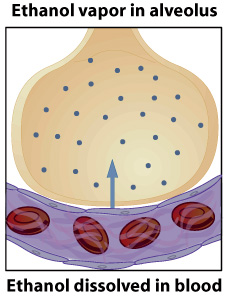As you breathe in, oxygen from the atmosphere enters the lungs and moves into the circulation through the capillary walls that surround the alveoli of the lung. When you exhale, both carbon dioxide and ethanol in the breath are removed from the blood (of course, not all of it!). Let’s look at this more closely.
- Ethanol dissolved in the mucous lining of the alveoli is in the liquid phase.
- Above the mucous layer is open space.
- As the ethanol vaporizes, the gas (vapor) expands to fill the air space within the alveolar sac.
- When you exhale, the vaporized ethanol exits the body. This is the same ethanol vapor that is measured by the Breathalyzer™ test to determine whether someone is intoxicated.
So, respiration not only provides the body a steady supply of oxygen, but also provides an exit for toxic waste products, including some volatile drugs like ethanol.
 Figure 4.5 As ethanol diffuses into the alveoli, it vaporizes to a gas. Ethanol vapor can be exhaled from the body.
Figure 4.5 As ethanol diffuses into the alveoli, it vaporizes to a gas. Ethanol vapor can be exhaled from the body.